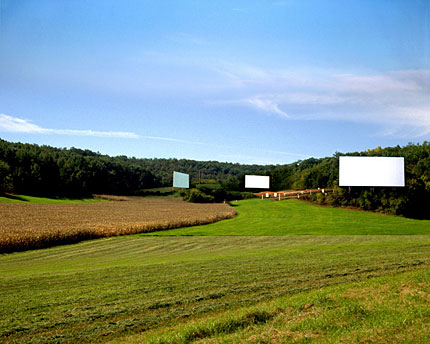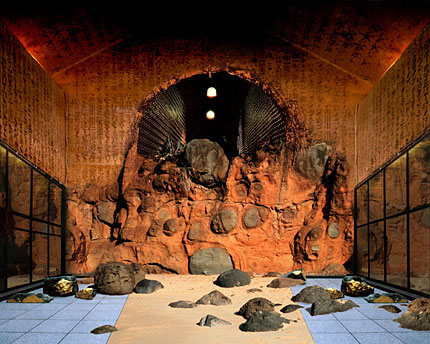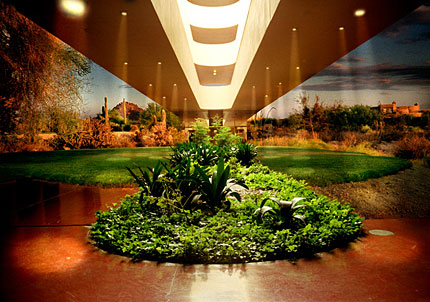Interview with Oliver Wasow
by Dana Hoey
Dana Hoey: How has being a younger member of the Pictures generation defined or influenced you?Oliver Wasow: I was very influenced by a number of artist's from the Pictures movement, particularly Jack Goldstein and James Welling. In retrospect I realize that their primary influence was not so much in the theoretical arena, but in the ways some of these artists embraced beauty and allowed themselves a kind of visual indulgence that had been taboo for some time. I can remember a sense of frustration in college when I learned that for years art had been moving towards an acknowledgement of the flatness of the picture plane and that if one chose to puncture this plane, or deal in illusionism while ignoring the "object hood" of art, you were in some way contributing to the catastrophic excesses of capitalism. I understood the connection conceptually but was skeptical of the efficacy of the strategy. I also felt that there was a certain almost puritanical morality at play in the denial of the pleasure inherent to illusionism.

Cross Plains, Wisconsin
This is not to say that these strategies weren't extended into the Pictures movement, only that it wasn't what appealed to me or influenced me. I also never really bought into the idea, expounded on by a number of critics central to the Pictures movement, that you could subvert the dominant codes of mass culture by adopting their language and turning it against them. Ultimately what appealed to me was, as I said before, that these artists were working visually and utilizing a language I understood, the language of pop culture.
It's important though to remember that they were not the only artists turning again to things visual. Even more present and on the scene at that time were the neo-expressionist painters. The neo-expressionists work held little interest to me because theirs was a participatory vision, all about the act of painting and the trace of the artist. I was and still am much more interested in the role of the spectator. I like process and for the most part making my work is fun for me, but in order for a piece to succeed it needs to be seamless and my presence invisible. For me looking at art is just that; looking. It's about entering windows and occupying spaces, passively.
DH: And in terms of your work, do you really want to be in these decadent, sometimes scary futuristic spaces?
OW: Yes. My pictures are travel photos, pictures of places I've been or would like to go, and things I've seen or would like to see. The places I depict are not always peaceful but they are always compelling to me. I don't think one should confuse beauty with the bucolic. A mushroom cloud is a horrific event but visually incredibly compelling. A sunset is a beautiful thing, even if it's made more beautiful by pollution.
DH: How much has straight art photography influenced you?
OW: I guess that depends to some degree on what is meant by "straight" photography. I've always been attracted to the theatrical and the cinematic and in that sense the work of traditional documentary photographers doesn't much interest me. But there is a whole world of photography that might be called "straight" by today's standards that was hugely influential to me. I'm thinking of someone like Weegee who is thought of in some ways as a documentary photographer and journalist but who, in my opinion, made some of the most theatrical and spectacular photographs ever made. Ansel Adams too, while being fairly traditional, understood the nature of drama in a manner that even Bierstadt or Church would have appreciated. I'm also very interested in photographers who manage to locate that strange place between the "straight" and the set-up. I'm thinking of someone like Jeff Wall, or yourself, artist's whose work requires a double take and leaves you not quite sure if what you're looking at is real or not. I've never really been able to show the restraint necessary to locate that space in my work; I tend towards the baroque.

Culebra, Puerto Rico
DH: But your work does seem to be getting less baroque and fantastic. For instance it seems you've moved from the inclusion of surreal objects in your landscapes (flying saucers) in the 1980's to very believable objects now (billboards, balloons). Also, in your landscapes, I've noticed a shift away from the overly romantic and painterly sunset skies towards a more serene "perfect-blue" sky.
OW: Yes, that's very true. Ironically, I think I'm making this shift due in part to the ubiquity of digital imaging technology. While digital imaging software has allowed me to create more seamless and illusionist spaces, it's also undermined the degree to which I can play off of the audience's expectations of what a photograph is. As the veracity and authority of the photograph has eroded, the questions people tend to ask about my photographs like "where is that?" "when was that taken" and "is that real?" have lessened. What this means is that the sense of mystery and displacement that a seamlessly altered and manipulated photograph can evoke has decreased as well. I miss this and recognize that in order to recapture it I might need to rein it in some. This doesn't mean that I've abandoned the surreal or fantastic, only that I'm choosing to locate it in things more real.
It's funny, when I first started showing work there were two major cinematic influences on my peers. One was Blade Runner, of course, and the other, less acknowledged, was Blue Velvet. In retrospect, in the light of artists such as Gregory Crewdson and Philip Lorca, it seems that perhaps the surreal banality of Blue Velvet was every bit as prescient as the more effects-laden world of Blade Runner.
DH: I wonder though to what degree this issue of believability and your works begging the question "is it real?" really matters to you? It seems to me that while there may be a certain critical legitimacy to these questions, you may in fact simply be an artist with a baroque vision; a vision that needs to be indulged.
OW: Yea, I suppose you're right. Perhaps because my work walks a thin line and occasionally tips in the direction of kitsch I fear I'm indulging myself too much. Maybe this is guilt born from my experience in late 70's early 80's academia or maybe it's a valid thing to be afraid of, I don't know really. But still, the issue of veracity is central to my work. All good spectacles are to some point dependent on illusion and illusion requires an expectation of reality to be effective.
If I were a painter this issue would be moot, but as long as my final product is a photograph, I think the issue of reality and believability is central to the viewers reaction to the work.

Marin County Convention Center
DH: So you're a photographer?
OW: Yes, maybe — I don't know really. I teach photography, or at least I teach in photography programs. In truth though I have no traditional dark room skills. I had to learn what an f-stop was in order to teach, and this was long after I had been showing my photographs in galleries. I'm definitely attracted to photographs and if I walk into a room where both photographs and paintings are hanging on the walls, I'll generally head to the photos first. But the photos I'm most attracted to share a lot of common ground with painting. I like a lot of advertising photography because it often employs very painterly techniques. Car ads, which I'm particularly attracted to, often utilize special effects to transcend the temporally and spatially specific nature of landscape photography and elevate the car (and the consumer) out of the mundane and everyday. I work in a similar way and have always regarded photography as a very plastic medium. The homemade special effects of my earlier work and the digital technologies I employ today are very painterly processes. Most of my time in the studio is spent pushing pixels around; mixing colors and modeling light and shadow. Far from being dead, I think painting is alive and well.
DH: Your earlier collage work in many ways prefigured the computer. Did you have any idea then that the computer would someday become so central to art making?
OW: When I was making art in the early 80's the computer was already being used in some capacity in a lot of the stuff I was visually attracted to, but it was a world that I definitely had no access to. I remember writing a letter to the Scitex corporation in 1983 asking if I could get time on one of their million dollar digital imaging systems in exchange for some artwork. They never got back to me. Today I've got a more powerful computer and better software sitting on my studio desk.
I don't think I was particularly prescient in my attraction to the computer, it's just that the computer happened to intersect with two of my defining interests; one, I am at heart a technological determinist, and two, I'm attracted to the aesthetics of collage.
If you believe, as I do, that technology has brought us to a world of social constructs that are in large part shaped by images, and if you're interested in re-configuring those images under the guise of art, then the computer is an obvious tool to be attracted to. What I never could of imagined was just how cheap and powerful the technology would become.

Tulum, Mexico
DH: You've talked a lot about process and tools but what about the content of your work?
What is the meaning of the imagery in your work?
OW: In many ways that's a more difficult question for me to answer. Some people go stream of consciousness with their process in order to locate the deeper "truth" of their vision, for me, I think I do that with the content. I don't make a lot of overt decisions about what I choose to include in my pictures, though I do think about it a lot afterwards. You asked me earlier about the shift from UFOs to balloons and suggested that this revealed a movement from the fantastic to the real. This is true, but I think the more fundamental attraction to me is that they are both relatively weightless and floating objects that work as visual metaphors for ethereal states of consciousness. This isn't to suggest that they aren't also signifiers of meaning. UFOs are of course the ultimate icons of the fabricated photograph, and hot air balloons are classic 19th century icons that juxtapose well with my more futuristic images. In the end though I think my content choices aren't really very conscious. I sit down with a lot of pictures and choose those that seem both visually and intuitively "right" for the picture I'm working on. Some of the imagery that recurs in my work, like clouds, fire, water and smoke, are there for the simple reason that they are visually compelling and serve as signposts for natural and man made spectacle. Other imagery is more specific and, paradoxically, less easy for me to account for. I do rule out a lot of imagery before I even get started. Few of the things you see in my pictures are historically or spatially specific. Even the architectural fragments are rarely of a "period". Generally speaking, I limit myself to things that while they could conceivably be found in this world, are difficult to locate in time or place.
DH: In your most recent photographs the landscape has moved indoors and you've created images of architectural spaces where the natural and the man made co-exist. Can you elaborate a little on this outside Ðinside dichotomy?
OW: A lot of my pictures contain architectural structures nestled comfortably into idealized landscapes. The buildings function as small signs of human presence, secondary to the landscape itself, sort of metaphoric places to stay while visiting the picture. Recently, perhaps as a result of spending a lot of time in Las Vegas, I've become interested in what happens when you reverse that hierarchy and bring the landscape into the building. I remember looking at pictures of Philip Johnson's glass house when I was younger and thinking that it was a great idea but also thinking that it seemed really cold and lonely. The glass separated the person in the house from nature even more than a wall - you could look but you couldn't touch. Frank Lloyd Wright, on the other hand, an architect that I saw a lot of growing up in Wisconsin, seemed to me to have it right. The trees should come up through the floor and out the ceiling. The water should flow under the floor. There are of course a lot of practical reasons why living things can't be incorporated into interior spaces and why, other than tropical plants in corporate lobbies or the occasional well maintained resort or casino, you don't see a lot of it in the world. I hope someone solves that problem soon but In the meantime I suppose that's one of the great things about making pictures, places don't have to be practical - or even actual places - to exist.
DH: And so you'll pre-visualize these ethereal and frightening spatial utopias, these travel photos of places you'd like to visit, and eventually, perhaps, technology will help us proceed towards places you've already seen.
© Oliver Wasow-Dana Hoey 2003
all images © Oliver Wasow, courtesy of the artist
For more information about Oliver Wasow please visit: www.oliverwasow.com